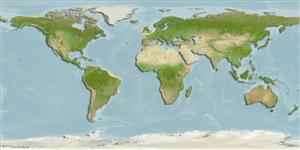>
Blenniiformes (Blennies) >
Blenniidae (Combtooth blennies) > Salariinae
Etymology: Hypleurochilus: Greek, hypo = under + Greek, pleura = in the side of + Greek, cheilos = lip.
More on authors: Quoy & Gaimard.
Environment: milieu / climate zone / depth range / distribution range
Οικολογία
Θαλασσινό(ά) βενθικό(ς). Tropical
Southwest Atlantic: Paraíba, Brazil (Ref. 57756) to Uruguay (Ref. 35204) and Argentina (Ref. 86332). Northeast Atlantic: Azores (Ref. 35204).
Μέγεθος / Βάρος / Age
Maturity: Lm ? range ? - ? cm
Max length : 8.9 cm TL αρσενικό/απροσδιόριστο; (Ref. 116953)
Adults feed primarily on amphipods and isopods (Ref. 9062). Oviparous. Eggs are demersal and adhesive (Ref. 205), and are attached to the substrate via a filamentous, adhesive pad or pedestal (Ref. 94114). Larvae are planktonic, often found in shallow, coastal waters (Ref. 94114).
Life cycle and mating behavior
Maturities | Αναπαραγωγή | Spawnings | Egg(s) | Fecundities | Προνύμφες
Oviparous, distinct pairing (Ref. 205).
Menezes, N.A. and J.L. Figueiredo, 1985. Manual de peixes marinhos do sudeste do Brasil. V.Teleostei (4). Museu de Zoologia, Universidade de São Paulo, Brazil. 105 p. (Ref. 9062)
IUCN Red List Status (Ref. 130435)
Threat to humans
Harmless
Human uses
Εργαλεία
Special reports
Download XML
Διαδικτυακές πηγές
Estimates based on models
Preferred temperature (Ref.
123201): 14.9 - 27.7, mean 23.6 °C (based on 330 cells).
Phylogenetic diversity index (Ref.
82804): PD
50 = 0.5005 [Uniqueness, from 0.5 = low to 2.0 = high].
Bayesian length-weight: a=0.00813 (0.00432 - 0.01529), b=3.02 (2.85 - 3.19), in cm total length, based on LWR estimates for this species & (Sub)family-body (Ref.
93245).
Τροφικό Επίπεδο (Ref.
69278): 3.3 ±0.53 se; based on food items.
Ελαστικότητα (Ref.
120179): Υψηλό, ελάχιστος χρόνος για διπλασιασμό πληθυσμού < 15 μήνες (Preliminary K or Fecundity.).
Fishing Vulnerability (Ref.
59153): Low vulnerability (10 of 100).
